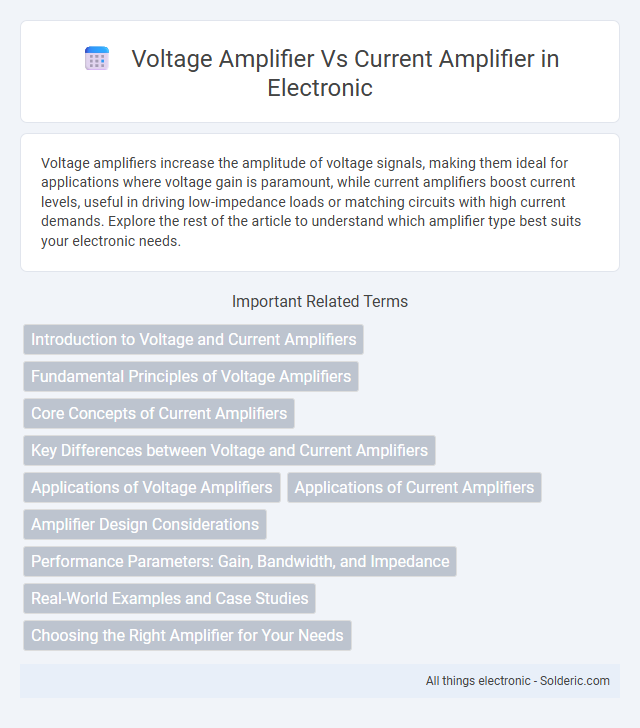Voltage amplifiers increase the amplitude of voltage signals, making them ideal for applications where voltage gain is paramount, while current amplifiers boost current levels, useful in driving low-impedance loads or matching circuits with high current demands. Explore the rest of the article to understand which amplifier type best suits your electronic needs.
Comparison Table
| Feature | Voltage Amplifier | Current Amplifier |
|---|---|---|
| Primary Function | Amplifies input voltage | Amplifies input current |
| Output Type | High voltage signal | High current signal |
| Input Impedance | High | Low |
| Output Impedance | Low | High |
| Typical Usage | Signal conditioning, sensor interfaces | Driving low impedance loads, power stages |
| Gain Parameter | Voltage gain (Av = Vout/Vin) | Current gain (Ai = Iout/Iin) |
| Example Devices | Operational amplifiers | Transistor-based current boosters |
Introduction to Voltage and Current Amplifiers
Voltage amplifiers increase the voltage level of an input signal while maintaining its current capacity, making them ideal for applications requiring high voltage gain and impedance matching. Current amplifiers boost the current of the input signal without significantly altering voltage, suited for driving low-impedance loads or delivering higher current to a circuit. Your choice between these amplifiers depends on whether voltage gain or current drive strength is the priority in your electronic design.
Fundamental Principles of Voltage Amplifiers
Voltage amplifiers function by increasing the amplitude of input voltage signals while maintaining high input impedance and low output impedance to ensure minimal signal loss. They operate on the principle of voltage gain, where the output voltage is a multiple of the input voltage, often achieved through transistor or operational amplifier configurations. Understanding these fundamental principles helps you select the appropriate voltage amplifier for applications requiring precise voltage signal amplification without significant current alteration.
Core Concepts of Current Amplifiers
Current amplifiers increase the input current to a higher output current while maintaining minimal voltage change, making them essential in applications requiring precise current control. They are characterized by high input impedance and low output impedance, ensuring efficient current transfer and signal integrity. Your choice between voltage and current amplifiers depends on whether the primary need is to boost voltage signal levels or to control current flow in the circuit.
Key Differences between Voltage and Current Amplifiers
Voltage amplifiers increase the amplitude of input voltage signals while maintaining high input impedance and low output impedance, ideal for driving voltage-sensitive loads. Current amplifiers boost the input current, featuring low input impedance and high output impedance to efficiently supply current to loads requiring higher power. Your choice depends on whether the application demands voltage gain for signal strength or current gain for driving larger loads.
Applications of Voltage Amplifiers
Voltage amplifiers are widely used in audio systems to increase signal voltage for driving speakers or headphones without significantly altering the current. They are crucial in instrumentation and sensor circuits where precise voltage signal amplification is needed for accurate measurements. Your electronic devices benefit from voltage amplifiers in applications such as radio receivers, medical equipment, and communication systems.
Applications of Current Amplifiers
Current amplifiers are crucial in applications requiring the amplification of low-level current signals for better processing, such as in photodiode sensors and electrometer circuits used in scientific instrumentation. They are widely employed in transimpedance amplifiers to convert current to voltage, enhancing the detection sensitivity in optical communication systems and medical equipment like ECG and EEG machines. Industrial automation systems also rely on current amplifiers for precise control and measurement of sensor outputs, improving accuracy and operational efficiency.
Amplifier Design Considerations
Voltage amplifier design prioritizes high input impedance to minimize signal source loading and maximize voltage gain, while current amplifier design emphasizes low input impedance for efficient current transfer and high current gain. Stability, bandwidth, and noise performance are critical parameters influencing both amplifier types, with the choice of transistor configuration (such as common-emitter for voltage gain and common-base for current gain) playing a significant role. Your amplifier design must balance these factors to ensure optimal performance suited to the specific application demands.
Performance Parameters: Gain, Bandwidth, and Impedance
Voltage amplifiers typically offer high voltage gain and high input impedance, making them ideal for applications requiring signal voltage enhancement without loading the source. Current amplifiers focus on current gain with low output impedance, ensuring efficient drive of low-impedance loads while maintaining wide bandwidth for better signal fidelity. When choosing between the two, consider your performance needs for gain, bandwidth, and impedance to optimize your circuit's overall functionality.
Real-World Examples and Case Studies
Voltage amplifiers are commonly used in audio equipment such as guitar amplifiers and radio receivers, where boosting signal voltage ensures clear sound quality without significantly increasing current. Current amplifiers are prevalent in power electronics and LED drivers, exemplified by case studies in industrial motor controls where maintaining constant current is critical for performance and safety. Real-world applications demonstrate voltage amplifiers' strength in signal processing, while current amplifiers excel in controlling power delivery in high-current environments.
Choosing the Right Amplifier for Your Needs
Choosing the right amplifier depends on whether you need to boost voltage or current for your specific application. Voltage amplifiers increase signal voltage with high input impedance suitable for sensor signal conditioning, while current amplifiers provide higher output current with low output impedance ideal for driving low-impedance loads such as speakers or motors. Evaluating the required input and output characteristics ensures optimal performance and efficiency in your electronic circuit design.
Voltage amplifier vs Current amplifier Infographic

 solderic.com
solderic.com